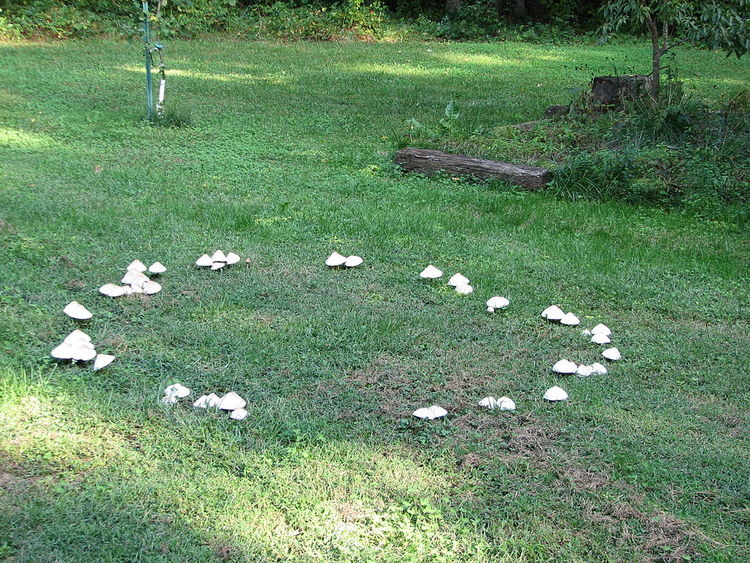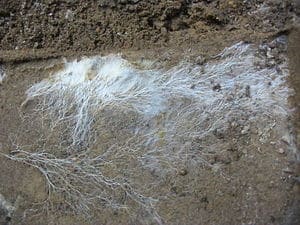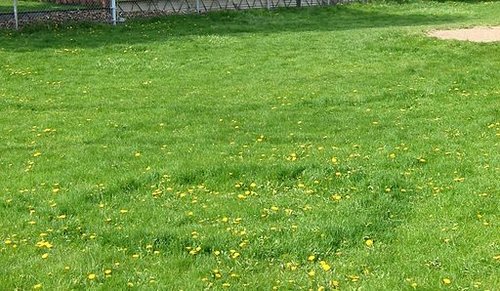Fairy Rings in the Lawn and How to Manage Them

Fairy ring with mushrooms visible
The overnight appearance of a mushroom “fairy ring” nestled in the grass may have enchanted you as a child, but as an adult homeowner with a lawn to care for you may have other feelings about this phenomenon. So how do you manage a fairy ring (notice we didn’t say “get rid of”?) First you need to know exactly what a fairy ring is.
A fairy ring develops as a fungus grows slowly from a central point, sending out hyphae in an ever widening circle. The hyphae are root-like structures that fungi use to absorb nutrients and water from their environment. Together the hyphae are known as a mycelium. This growth is completely underground and can reach up to 10 meters in diameter.
Sometimes after a rainfall the mycelium will produce mushrooms at the edge of the growth ring. This is the fairy ring that seems to appear overnight after a rain. These are the fruiting bodies of the mycelium. Spores will be dispersed and under the right conditions a new mycelium/mushroom will arise.
(Although they are in a biological kingdom of their own, neither animal or plant, you can think of a fungus as a plant-like organism, with the hyphae similar to roots and branches, and the visible mushrooms as “flowers”.)

Filaments of hyphae combine to form a structure known as a mycelium.

The ring of darker, more vigorous grass indicates the presence of a Fairy Ring. The faint edge of a larger ring is visible beyond the ring in the foreground as an arc.
As the ring grows, the hyphae on the leading edge of the ring produce enzymes that break down nutrients in the soil into components that are easier to absorb. This also makes the nutrients more available to the grass growing at the leading edge, occasionally resulting in a ring of dark green, vigorous grass. In some situations, the grass on the leading edge of the ring may be dead.
The center of the ring becomes depleted of nutrients as the mycelium absorb them and grow outward. Additionally, the mycelium is very water-resistant and can create a zone where water does not easily penetrate, making the soil in the center of a fairy ring unusually dry. These two factors can weaken or even kill grass in the center of a fairy ring. It’s important to note that the mycelium do not parasitize or directly damage the grass at all.
Both the mushrooms and the ring of unusual grass growth can affect the aesthetics of your lawn. To treat the mushrooms of a fairy circle, the mushrooms can be mowed, kicked or raked out as soon as you notice them, preferably before the caps open and the spores disperse.
In the ring’s center where the mycelium resists water, aeration can help water penetrate. (You can “aerate” the ring with a garden fork by hand. For about a month, apply extra water to this area only to avoid over-saturating the surrounding unaffected area.) To address the depletion of nutrients, particularly nitrogen, some extra fertilizer that’s high in nitrogen—and preferably organic—applied by hand within the circle can make up for what the mycelium has consumed.
A lawn growing in fertile, healthy soil will not only resist infection by fairy ring fungus, but in the event the lawn is affected, the symptoms are much less noticeable. Periods of drought can also contribute to the fungus getting a foothold, so a properly watered lawn will be more resistant to developing the problem.
There really isn’t a guaranteed-to-work chemical (fungicide) that can control fairy ring. Although they look nearly identical, there are actually many species of mushroom that cause fairy rings and only some will respond to fungicides at all. The best management solution in lawns is to manage the water and fertility of the soil, and to remove the visible mushrooms when they appear.
If your lawn only shows evidence of a fairy ring when the mushrooms appear, congratulations-your lawn is probably healthy and well cared for and you don’t need to do much beyond remove them. If you can see significant evidence of the rings even when the mushrooms haven’t sprouted, your lawn may be telling you it needs more water and fertilizer.
(Hopefully we don’t have to tell you not to try eating the mushrooms of a fairy ring, right? Many of the species that form fairy rings are very toxic. Don’t eat them!)
Photo Credits:
- Fairy Ring by Aviddoghug at English Wikipedia (Original text: David Gough) [Public domain], via Wikimedia Commons
- Hyphae by Lex vB at nl.wikipedia (Transfered from nl.wikipedia) [Public domain], from Wikimedia Commons
- Fairy Ring School Field by Kelisi [Public domain], via Wikimedia Commons